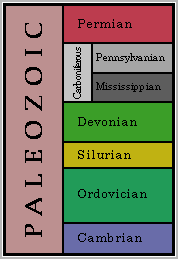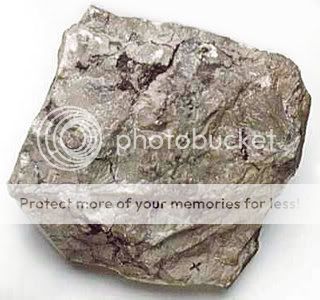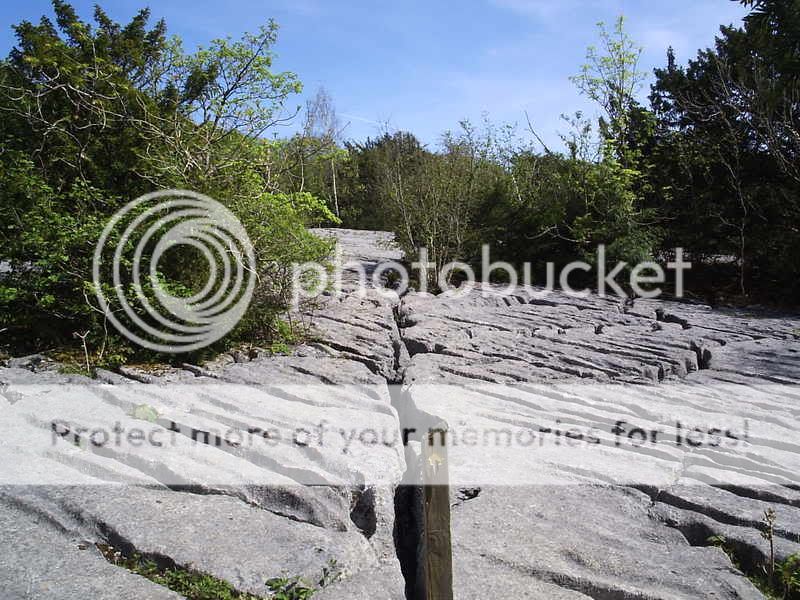It is situated just over 1 mile away from the Lancashire town of Carnforth, and can bee seen for miles around due to its height. The way it looks today is due to the Carboniferous period in our Earth history, which is also one of SIX* periods in the PALEOZOLIC era, the Carbomiferous period took place about 350 to 290 million years ago, The term "Carboniferous" comes from here in England, in reference to the rich deposits of coal that occur here, The SIX periods of the Paleozolic era are as follows: * Cambrian *Ordovician * Silurian * Devonian * CARBONIFEROUS (350 to 290 million years ago) * Permian, A diagram can be seen more clearly below:

CARBONIFEROUS limestone is a sedimentary rock made of Calcium carbonate. It is generally light-grey in colour, and is hard. It was formed in warm, shallow tropical seas teeming with life. The rock is made up of the shells and hard parts of millions of sea creatures, some up to 30 cm in length, encased in carbonate mud. Fossil corals, brachiopods and crinoids are very much in evidence as components of Carboniferous limestone; indeed the rock is full of fossils. Carboniferous limestone which can be found all over Warton Crag, an example of Carboniferous Limestone can be seen below:

The stone has horizontal layers with bedding planes, and vertical joints. These joints are weaknesses in the rock, which are exploited by agents of both denudation and weathering. They also lead to the most important characteristic of Carboniferous limestone - its permeability. Rain water over time seeps through the joints in the limestone. This creates a landscape that lacks surface drainage but which has all manner of characteristic surface and subsurface features. The Carboniferous Limestone has been folded and faulted by massive Earth movements which can be seen by the fact that the rocks are now above sea-level and no longer horizontal, here on Warton Crag you can see these limestone outcrops jutting out from the grassy areas of the hill compared with the rest of the nearby relatively low terrain, Some of the level terraces on the Crag have outcrops of limestone exposed as pavement, a rare habitat in which slabs of rock are separated by deep cracks, an example of which can be seen below,

I took this photograph to show the really unusual lanscape, this is roughly 3 miles from Warton Crag but still part of the development of the entire area during the Carboniferous period, you will see Limestone Pavement on the Crag too but I don't want to spoil it for you ! notable rare plant species on Warton Crag include Rigid Buckler-fern, Pale St. John's Wort and Angular Solomon's-seal. Unfortunately, the waterworn slabs are in demand for rock gardens, and much pavement around here has, in the past, been irreparably damaged. April and May are the most spectacular months for the woodlands when the ground is carpeted with a mosaic of flowers; Wood Anemones, Bluebells, Primroses, Early Purple Orchids, Violets, Pignut and Wood Sorrel. Strickland Wood, with its moist, shady conditions, is an excellent habitat for ferns. The fronds of Hart's-tongue can be seen emerging from the moss-covered boulders, while Male Fern and Broad Buckler-fern prefer deeper soils. Warton Crag due to it's proximity to the local nauture reserve also provides a great chance to see some rather rare birds, Peregrine Falcons have been sighted on numerous occassions.. Warblers are an outstanding feature of the reserve in early summer, when Chiffchaffs, Willow and Garden Warblers, Blackcaps and Whitethroats fill the air with song. There are still a few Tree Pipits; but the Yellowhammers and Linnets, which used to be so conspicuous, have practically vanished.
The view from the top is quite superb, great views are to be found looking right out over Carnforth and Morecambe bay, also over to the Forest of Bowland and the Lake District.
At the parking place there is an information board provided where more information about the site can be found including the rare butterflies and plant life that can be seen. Sturdy boots are reccomended as the ground is very uneven in places, the best way to get to the summit is from the parking area nearby and up a clearly marked path, this may be a little slippy after rainfall, if you wish to continue your walk you may carry on past the trig point and drop down to the nature reserve waters, agagin there are plenty of signposts, have a great day out !
To claim this cache please answer the following questions and email me the answers, please don't post answers in your logs for obvious reasons:
1: What are the big cracks in the Limestone pavement called, AND how were they formed ?
2:What other item man made item is at the summit apart from the trig point, and what did it used to be used for ?
Finally - pease post a photo on your log with you or your GPS with the Trigpoint at the summit or with the Limestone pavements looking out over the view.
Any logs without relevent information required and photo's will be deleted.

PLEASE NOTE: I receive a very high number of Earthcache emails, I can’t reply to them all otherwise I’d be doing nothing else all day, as has always been the case there is no need to await a reply from me regarding your answers…. However due to numerous people thinking they can just log these caches without emailing any answers, and/or completing the required tasks these will be picked up, and the logs will be deleted without further communication. To facilitate this Please email your information either before, or AT THE SAME TIME OF LOGGING THE CACHE, Thanks.